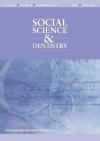Social Science and Dentistry

- Cover Date:
- September 2013
- Print ISSN:
- 2040-4263
- Vol:
- 2
- Issue:
- 2
Editorial
Introduction
This edition of the journal is the first after what seems like a long break – our previous issue being published in June 2012. During this break we have sought to negotiate access to the journal for all members of the Behavioural, Epidemiological and Health Services Research Group of the International Association for Dental Research (IADR) and this edition is the first that will be available to all members of that group. We are delighted to be able to offer the members of this group access to the online journal and we would encourage members to submit their research for publication in the journal. We are also looking to publish special issues of relevance and interest to the members of the BEHSR group and will provide an update on that in our next number. The papers in this edition of the journal clearly demonstrate the breadth and depth of work being conducted in the dental field from a social science perspective, with examples of theoretical, methodological and empirical work, and papers from Europe and Australia. In Gibson and Exley’s paper we have a theoretical exploration of the mouth as a theme within sociology. A review of existing sociological work on the mouth demonstrates the role of social symbols in regulating and controlling mouths and the site of the mouth as a permeable boundary of the body and a site of self-presentation. In her paper, Bonetti, explores the utility of psychological theories as a way of evaluating clinician compliance with guidelines within the context of evidence based practice. Whilst work exists globally, there is little translation work within dentistry in the UK, and the paper demonstrates the potential of this area in promoting evidence based oral health care. Following on from this Randall et al. present a study examining the impact of literacy levels on psychosocial self-report data in oral health research. They suggest that levels of certain types of missing data could be decreased through the use of computerised administration of questionnaires. The remaining three papers present the results of empirical work exploring experiences, anxiety and expectations related to dental disease and treatment. In their paper, Buchannan et al. present the results of a questionnaire based study on the role of patient expectations in recovery from third molar extraction surgery in Nigeria. The Self-Regulatory Model was found to be only moderately successful in predicting outcome but was useful as a framework for exploring preoperative expectations. We then move to Australia for a qualitative study by Mullens et al. on the impact of dental disease on a sample of Aboriginal adults living in New South Wales. The main impacts were pain, embarrassment, and difficulty eating, and the cost of treatment was identified as the main barrier to seeking care. The provision of free dental care in Aboriginal dedicated clinics was proposed as a potential solution. The final paper in this edition presents work carried out in Cyprus on the development of a comprehensive questionnaire on the aetiology and maintenance of dental anxiety utilising the Cognitive Vulnerability Model (CVM). The findings suggest that CVM is useful in understanding the maintenance of dental anxiety but that further work is required to understand dental anxiety acquisition and the role of CVM in this process. The work outlined here demonstrates the breadth and complexity of work currently being carried out through the application of social sciences to dentistry. As editors, we hope that the link that Social Science and Dentistry now has with the BEHSR group will encourage more of you to submit articles to the journal and help to strengthen both the, already impressive volume of work in this area and the status and visibility of the social sciences within the dental field.
- Article Price
- £15.00
- Institution Article Price
- £0.00
- Page Start
- 49
- Page End
- 49
- Authors
- Tim Newton, Sasha Scambler
Articles from this issue
- Title
- Pg. Start
- Pg. End
- The Impact of Dental Disease on a sample of Aboriginal adults living in the Central Coast Region of New South Wales Australia
- 73
- 79
- Collecting psychosocial self-report data in oral health research: impact of literacy level and computerised administration
- 80
- 87
- Pre-operative expectations and recovery outcomes for third molar extraction surgery in Nigeria
- 88
- 94
